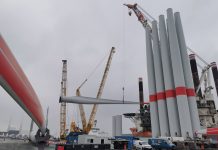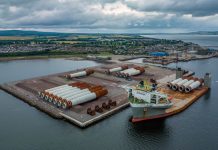To unlock floating wind’s massive potential, ship yards in Korea, Japan, China, and elsewhere require standardized solutions that support serial production and modularization for competitive, responsive project delivery. The term “constructability” summarizes this need.
With some major floating wind projects likely to begin construction by 2023, the well-known DNV GL class for ships and offshore structures rules can provide reassurance on cost and risk when making development choices. For example, the company’s new class rules for floating offshore wind turbine installations (DNVGL-RU-OU-0512) combine offshore, energy, maritime, and digital expertise into an integrated rule set. These rules complement DNV GL’s existing verification and certification services and standards for floating wind, thus providing well-tested rules and standardized processes for the new structures. In this way, both experienced and new players in the offshore project ecosystem can have a familiar framework to integrate new processes into existing production structures with confidence.

Owners, yards, original equipment manufacturers (OEMs), and others are used to working with DNV GL’s standards, are familiar with the process, and know the acceptance criteria. Studying the benefits of such familiarity in the oil and gas industry, it was found that using a new standard instead of an existing one increased the uncertainties and cost of project phases in the yard.
The new rules are timely. Floating wind is moving up the agenda for governments worldwide as they set targets to decarbonize their energy systems and promote green jobs growth for economy recovery.
As a part of these efforts, some yards might initially be looking to win as much work associated with floating wind as possible. However, they may be hesitant if this threatens to tie up their traditional ship and offshore capacity, as these wind projects will often be large-scale, intensive, multi-year projects. On the other hand, yards already have an excellent project and supply chain management track record and could use these skills to manage the needed capacity for floating wind projects.
Other yards might tender for more of the fabrication work, but could also potentially spread some of this work among subsidiary yards to maintain their capacity. Additionally, and depending on the OEMs, yards may also bid to integrate the floater with the tower and possibly also the wind-turbine nacelle and blades, essentially undertaking the full commissioning of the unit at quayside before float-out.
Substantial quayside space and deep berths will be needed for marshalling and assembling structures with deep drafts. Large projects might support investment in yard infrastructure to create capacity and enable local content. Smaller projects may make yards think twice about the scope and scale of what they bid for.
To support decision making, DNV GL’s new class rules cover all potential floater (hull) designs for floating wind: barge, semi-submersible, vertical floating columns (spar) and tension-leg platform.
Class rules also work with design and construction follow-up to verify that a unit was built according to design. Some owners now request class because it can also apply to operations follow-up, so that learnings from operations can be fed back through frequently updated rules.
DNV GL’s new class rules are designed to scale as they consider not just the individual units but the entire floating wind field with data-based services and condition-based monitoring and through linking with fatigue methodology sensor data. For tow-out, floating wind will involve large-scale use of existing ships, such as tugs. However, some specialist mobile units will be needed for maintenance work offshore, and there may be a need for a new class of crane vessel with enormous reach for floating wind -turbine installation.
More info www.dnvgl.com





































